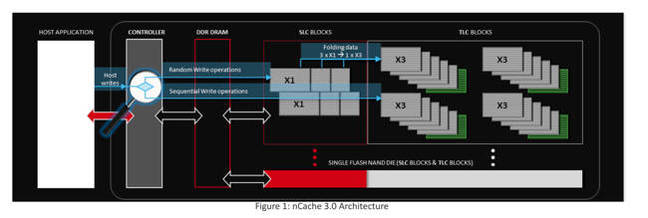This article is more than 1 year old
SanDisk offers super-slim terabyte SSD to tablet-pushers and other bulge-watchers
X400 comes in 2.5-inch and M.2 form factors
CES SanDisk has launched a super slim M.2 SSD at CES in Las Vegas, the 1TB X400.
It stores up to 1TB and is 1.5mm high in its single-sided M.2 format, coming also as a 2.5-inch SSD. SanDisk says it's the world's thinnest 1TB M.2 drive and is suited for OEM needs with thin devices such as tablets. It's being called a "client" SSD product, so expect it to be slipped into other devices.
The X400 follows on from the X300 and, like that drive, uses TLC (3bits/cell) NAND, and bas the same 128GB, 256GB, 512GB and 1TB capacity options. The X300 uses 1YNm NAND and SanDisk hasn't said what NAND technology is used in the X400. We'd guess it uses smaller NAND cells, though.
It uses low-density parity-check (LDPC) error-correcting code and not BCH code (used in QR codes), which is said to be less powerful than LDPC as NAND density increases.
The nCache caching technology, with a fast SLC (1 bit/cell) buffer, has moved on from the 2.0 version seen in the X300 to v3.0.

SanDisk states: "Random write data is handled by the SLC blocks, thus providing fast response times similar to an SLC SSD. Sequential write data is sent directly to TLC blocks. As the SLC portion of the memory is filled up, its contents are migrated to the TLC main storage partition, resulting in a 3-1 savings in storage space and freeing up space in the SLC to handle new data writes."
The SLC cache enables random writes to be aggregated and written to the TLC memory as sequential writes, helping to prolong the drive's overall endurance. A 256GB X400 SSD was rated to operate for more than five years with a workload of approximately 40GB/day. The 1TB drive supports 350TB written to it, which beats the 1TB X300's 80TBW.
A 256GB X300s has a 71,193 PCMark Vantage score and a 256GB X400 exceeds that, scoring 78,785.
We understand the X400 has a 6Gbit/s SATA interface.
SanDisk has supplied neither random read and write IOPS, nor sequential read and write bandwidth data. There is no data sheet and no pricing information – but the drive is, we're told, currently available.
SanDisk has an X400 technology backgrounder here (pdf). ®
